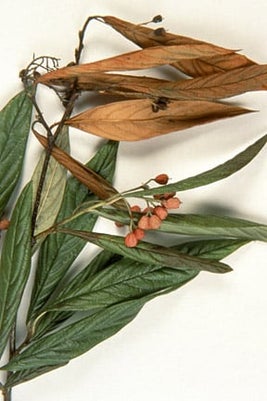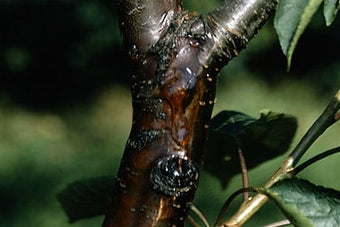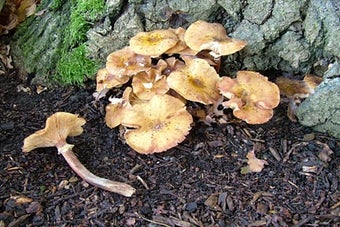
Quick facts
Common name - Fireblight
Scientific name - Erwinia amylovora
Plants affected - Apples, pears and related ornamentals
Main symptoms - Blossoms wilt, slime oozing from infections, cankers
Caused by - Bacterium
Timing - Late spring until autumn
What is fireblight?
Fireblight is a disease caused by the bacterium Erwinia amylovora. Expect to see damage from late spring until autumn.
Fireblight chiefly affects those members of the Rosaceae family producing a type of fruit known as a pome fruit: apples, pears and related ornamentals including Cotoneaster, Sorbus, Crataegus (hawthorn), Photinia (syn. Stransvaesia) and Pyracantha.
Prunus species, such as plums, cherries, peaches and apricots produce a different type of fruit (stone fruit). Whilst fireblight has occasionally been recorded on Prunus species, shoot or branch dieback affecting Prunus is far more likely to have been caused by another problem, such as blossom wilt or bacterial canker.
Symptoms
You may see the following symptoms:
- Blossoms wilt and die at flowering time
- A slimy white liquid may exude from infections in wet weather
- Shoots shrivel and die as the infection spreads down the inner
- During the short period of active spread, the outer wood is stained a 'foxy' reddish-brown colour (similar to the colour of fox fur) when the infected bark is peeled back
- Cankers (areas of dead, sunken bark) on branches, especially where infected shoots join larger branches

Control
Non-chemical control
Prune out and burn infections promptly, peeling back the to reveal the reddish-brown staining and cutting back 30cm (1ft) to healthy wood in smaller branches, 60cm (2ft) in larger ones. Wipe pruning tools with disinfectant (Jeyes Fluid or methylated spirit) between cuts to avoid spreading the bacteria. Remove secondary, late blossoms before they open.
Hawthorn hedges can be a source of infection and should probably be avoided by commercial fruit growers, but have many merits and should not be rejected by gardeners on this basis.
The most susceptible fruit was the pear ‘Laxtons Superb’, but this is no longer grown or offered for sale. The ‘Saphyr’ range of Pyracantha cultivars are resistant.
Chemical control
There are no chemical controls for fireblight.
Biology
The bacterium is to North America and was accidentally introduced into the UK in 1957. It was formerly a notifiable disease but this is no longer the case in mainland Britain; however it is not yet established on the Isle of Man or the Channel Islands. Suspected cases in these areas should be reported to the relevant plant health authority.
The bacteria overwinter in cankers. In warm, wet and windy weather in spring, bacteria ooze out of the cankers. Infections occur when the bacterium gains entry to the inner bark, usually via the blossoms, and it is spread by wind-blown rain and also by insects including bees.
Under favourable conditions the infections spread rapidly down the inner bark at up to 5cm (2in) per day, staining the cambium a foxy reddish-brown colour. Severely attacked trees appear to have been scorched by fire. Most years in the UK are too cold at blossom time for infections to occur and the disease is usually of relatively minor importance. A particular risk of infection occurs when trees produce a secondary, small flush of blossom later in the season when conditions are warmer.






